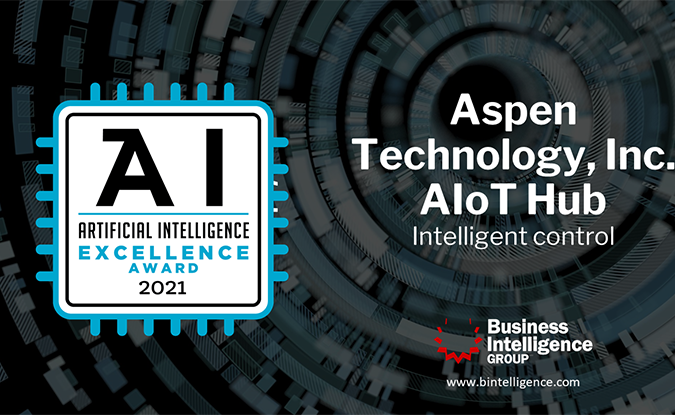Frederic Bastien, VP of Product Management and R&D for AIoT Solutions delivered an insightful presentation at the recent AspenTech OPTIMIZE 2021 conference. He started off by introducing the overarching Aspen Digital Reference Architecture for Asset Optimization Portfolio and delved deeper to explain how the Aspen Artificial Intelligence of Things (AIoT) HubTM provides the Industrial AI Infrastructure for this vision.
Aspen AIoT Hub is the Industrial AI Infrastructure
He explained how the Aspen AIoT Hub underpins the Industrial AI strategy for all other AspenTech solutions by supporting the portfolio’s cloud-enabled Industrial AI apps, integrated solution roadmap and cloud convergence strategy. The premise behind this offering is that not every industrial organization has an army of data scientists. Which is why AspenTech has brought to market this fit-for-purpose, cloud-ready, built-for-industry infrastructure to embed AI into various domain-specific industrial applications - that empowers domain experts as well as data scientists to unlock the business value in industrial data. He articulates how Industrial AI is very different from the generic AI solutions offered by various horizontal cloud vendors – while being well-suited to delivering measurable business outcomes in the industrial sector. It is this purposeful blend of data science and AI/ML, advanced analytics together with the domain expertise, which includes first-principles engineering as well as the underlying physics, chemistry and math parameters packaged into domain-specific, software-at-scale applications that deliver real-world value.
A Walk Through the Components of the Aspen AIoT Hub
Fred then went deeper into the different architectural components of the Aspen AIoT Hub full-stack solution on which AspenTech is building its next-gen of Industrial AI applications, and which enables customers and partners to collaborate to build their own AI-enabled, data-rich applications using a wide range of capabilities.
First off, on the data historian side (Aspen InfoPlus.21®), AspenTech has delivered a new evolution called Aspen MES Collaborative™ which enables users to set up their cloud-ready, enterprise-level historian that works hand-in-hand with plant and site historian products. By deploying the Aspen MES Collaborative, not only greater capacity, performance, and scalability are achieved, but also smaller sites benefit; and furthermore, the inherent high-availability capabilities can eliminate the ripple effect of data loss and other data management issues.
Second, Frederic spoke about the compelling enhancement to Aspen Cloud ConnectTM. In V12 and V12.1 AspenTech introduced a number of capabilities from the security and performance standpoints, with the gRPC connectivity to IP.21 as well as several source and destination plug-ins. In V12.1, AspenTech has added new capabilities and functionality that support the integration of data across other third party historians, including OSIsoft PI. Some plants working with IP.21 and others with the PI system are now able to connect to historians seamlessly and bring all the tags, timeseries and the contextual data into the destination servers with the help of Aspen Cloud Connect. In addition, Aspen Cloud Connect is now the integral part of Asset Performance Management (APM) and provides new connectors to Aspen Mtell®. If customers need to do advanced analytics, it is not enough to just have a set of tags with labels. They need to know the context around it, what asset it belongs to, and what is happening around that set of tags and labels. Contextual data can be pulled across Aspen products such as Aspen Manufacturing Master Data Manager (mMDM) and Aspen Production Record Manager (APRM) or from third party sources, and can be brought into the Aspen cloud-based historian or the Aspen Cloud storage of the Aspen AIoT Hub, driving the integration and mobility of industrial data across the plant as well as the enterprise.
Third, moving to Aspen Enterprise Insights™, Frederic mentioned that this is the solution for digital workflows enabling enterprise governance – facilitating the path from data to decisions. Within the interface of Aspen Enterprise Insights, users can click-through without coding and create new apps and workflows to fit their business processes. A ready-to-use template of a solution can be deployed in different organizations without recreating anything. If users are building a set of pipelines, workflows, or communities to manage capital projects, they can replicate a solution with just a click-of-a-button within Aspen Enterprise Insights. AspenTech also introduced version management of those workflows so that users can modify workflows over time and keep track of different versions. Aspen Enterprise Insights also unveiled a new use case for the Pharmaceutical industry, in particular, where there is a big need for audit trails and compliance.
All the benefits mentioned above are available both in the Software-as-a-Service (SaaS) deployment model, where Aspen Enterprise Insights is entirely running on the Aspen cloud infrastructure, and in the hybrid cloud deployment, where the application is managed by AspenTech but the data remains on-premise on a server or on a VPC on Azure or AWS. This highlights one of the most important benefits of Aspen Enterprise Insights, which is greater flexibility while delivering accelerated time-to-insights.
AIoT Use Cases to Accelerate Your Industrial Digital Transformation
Next, Frederic talked about Aspen Industrial AI Workbench™, launched in V12.1, and one of its components, Aspen Data Science Studio (DSS)™ which is a cloud-ready, production-grade embedded Jupyter notebook environment that is built with industrial data scientists in mind. Through this innovative application, AspenTech has brought to market a full-fledged collaboration environment for data scientists and domain experts where they can share models, exchange and tune datasets, review and work together on pieces of codes, and embed their IP through dependency sets and plug it in to use within the Python code inside DSS, as well as train and test different Industrial AI/ML systems. In addition, users can deploy models straight from DSS, run model inference, monitor and validate results, and retrain a model or push it back. This approach makes the Aspen Industrial AI Workbench one of the most compelling solutions for Industrial AI apps on the market today.
At the end, Frederic went through some examples of AIoT use cases to bring your Industrial AI strategy to life:
- Process Historian in the Cloud: The goal is to provide an evolutionary and convergence path for data historians from the edge to the cloud as well as across plants and sites. Subsets of tags and data across multiple sites can be aggregated and integrated into one central historian which can be in a data center or in the cloud. Since users build applications and analytics on top of the historian, they can now be deployed and managed in one place. This approach supports smaller sites that do not have a historian due to the economic cost of implementation. High-availability and streamlined upgrades are other powerful capabilities of the Aspen MES Collaborative.
- Industrial Data Lakes For AL/ML/Analytics: The intent is to harmonize the accessibility of operational/industrial data across the enterprise for advanced AI/ML and analytics needs. For example, when customers get the next-gen of AspenTech’s cloud-enabled products built on top of the Aspen Cloud, they inherently get access to a cloud storage capability that is built on top of AWS and Azure and is totally vendor-agnostic. This ready-to-use and accessible data powers newer data-rich apps across the enterprise. On the other hand, if customers have their own data lake strategy, Aspen Connect can become the right tool to bring that stranded data, which is very difficult to get from assets and plants, to the cloud vendors or any open-source database supported as a destination server by Aspen Connect.
- Digital Workflows and End-to-End Governance: The purpose here is all about actionability. There is a new functionality in the Aspen Enterprise Insights pipeline to create new types of actions that acts as a control tower over different operations.
- Industrial AI Collaboration Environment for Data Scientists: Domain engineers and data scientists used to work in silos, not sharing their results with one another, or to work on different datasets. With Aspen Industrial AI Workbench, the collaboration between different organizations is now facilitated and further enhanced.
- Intelligent Edge: This is a new solution for AspenTech. It enables all the digital twins and models that are created by AspenTech applications or by internal data scientists to be deployed below the firewalls in Aspen Intelligent Edge. The objective here is to be able to monitor, maintain and orchestrate ML models, AI agents and twins at the plant edge, and to support both ONNX and proprietary models.
For more information about Aspen AIoT Hub, visit our solutions page.





Leave A Comment